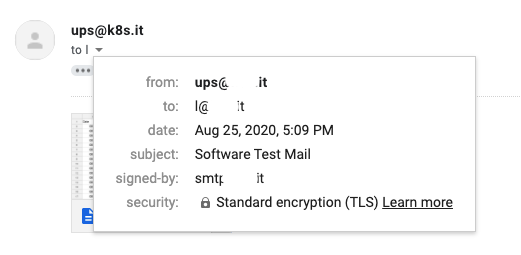Long story short my vps provider changed the ammount for the small instance from 1$ to 3$,
so i took the advantage to switch my postfix service from cloud to onprem.
Why, since the world is moving to cloud ?
Because my own domain is used just for alerting and small other stuff and 3$ month is crazy :)
Anyway i'll lost some good stuff like static ip and possibility ti have a ptr dns.
Shit happens it's just for my stuff.
However we have 3 different topics to describe in this project
- what is an email
- postfix configuration
- postfix in kubernetes
Send email sometimes is a dedicated work in an enterprise company.
There are many aspect to consider , not only infrastructure , like che segmentation of domains strategy,
email answer engagement and each isp is using a different threashold to mark your email as a spam,
however now we will focus only on the generic configuration with some minimum requirements.
Here some topic that you probably know:
- TLS (add an encrypted connection in delivery)
- Sender-Id (mostly used for microsoft ecosystem)
- PTR record (used to check the corrispondence of a real smtp)
- SPF record (used on TXT level to define an whitelist of "smtp allowed to ...")
- Dkim (a private and public certificate to match the smtp and emails)
- Dmarc (a mix with SPF and Dkim to protect the domain from unauthorized use )
The second one is more related to middleware behaviour
i have a domain "example.com" and i'd like to
- receive email from and to this domain
- have catchall system to do not configure any email account but using everything [email protected], [email protected], [email protected]
- relay all the emails to my gmail account
- reject the email that are tried to sent outside my chosed domains
For all those topics the main configuration is in virtual and transport map in postfix
There are some articles in internet, i'll avoid to reinvent hot water with the explanation.
just as recap this was the configuration in the cloud vps
now i just whitched the MX to my own microk8s lab
However , inside the box a lot of implementation way can be taken
you can build an image for each dedicate purpose
- postfix
- rsyslog
- opendkim
- tls
looking the configuration adopted in Scenario 1 , you can add an ingress tcp forward where
you can also add a tls layer with cert-manager (the new kube-lego).
Scenario 2 plus external storage for logs
etc etc
Embedded docker images with all you need with a node port (used only because i have a standalone kubernetes node).
Well having everything in one single container the docker image reflect the pachage used in a virtual machine
FROM debian:buster
MAINTAINER lgirardi <[email protected]>
EXPOSE 25/tcp
RUN apt-get -y update && apt-get -yq install \
postfix \
bsd-mailx \
opendkim \
opendkim-tools \
sasl2-bin \
rsyslog \
supervisor
# Add files
ADD run.sh /opt/run.sh
# Run
CMD /opt/run.sh;/usr/bin/supervisord -c /etc/supervisor/supervisord.conf
where the run.sh is the supervisord daemon managing the process.
- postfix
- rsyslog
- opendkim
The structure used is done to leave the configuration as a configmap and secrets
this will help in case you have to tune your system whiout regenerate the images that
honestly make no sense to be build each deploy.
As you see the deployment files has a huge number of volumes
apiVersion: apps/v1
kind: Deployment
metadata:
name: postfix
namespace: postfix
spec:
replicas: 1
strategy:
type: RollingUpdate
revisionHistoryLimit: 10
selector:
matchLabels:
app: postfix
template:
metadata:
labels:
app: postfix
spec:
containers:
- name: postfix
image: lgirardi/kubernetes-postfix:v0.2
lifecycle:
postStart:
exec:
command: [ "bin/bash", "-c", "postmap /etc/postfix/virtual && postmap /etc/postfix/transport && supervisorctl restart postfix" ]
securityContext:
capabilities:
add:
- NET_ADMIN
ports:
- name: smtp
containerPort: 25
volumeMounts:
- name: opendkim-key
mountPath: /etc/mail/dkim-k8s/keys/YOUR_DOMAIN/YOUR_DOMAIN.private
subPath: opendkim-key
- name: ca-crt
mountPath: /etc/postfix/tls/ca.crt
subPath: ca-crt
- name: ca-key
mountPath: /etc/postfix/tls/ca.key
subPath: ca-key
- name: postfix-transport
mountPath: /etc/postfix/transport
subPath: transport
- name: postfix-virtual
mountPath: /etc/postfix/virtual
subPath: virtual
- name: postfix-headerchecks
mountPath: /etc/postfix/header_checks
subPath: header_checks
- name: postfix-maincf
mountPath: /etc/postfix/main.cf
subPath: main.cf
- name: postfix-opendkimconf
mountPath: /etc/opendkim.conf
subPath: opendkim.conf
- name: postfix-keytable
mountPath: /etc/opendkim/KeyTable
subPath: KeyTable
- name: postfix-signingtable
mountPath: /etc/opendkim/SigningTable
subPath: SigningTable
- name: postfix-trustedhosts
mountPath: /etc/opendkim/TrustedHosts
subPath: TrustedHosts
volumes:
- name: postfix-transport
configMap:
name: postfix-conf
items:
- key: transport
path: transport
- name: postfix-virtual
configMap:
name: postfix-conf
items:
- key: virtual
path: virtual
- name: postfix-headerchecks
configMap:
name: postfix-conf
items:
- key: header_checks
path: header_checks
- name: postfix-maincf
configMap:
name: postfix-conf
items:
- key: main.cf
path: main.cf
- name: postfix-opendkimconf
configMap:
name: postfix-conf
items:
- key: opendkim.conf
path: opendkim.conf
- name: postfix-keytable
configMap:
name: postfix-conf
items:
- key: KeyTable
path: KeyTable
- name: postfix-signingtable
configMap:
name: postfix-conf
items:
- key: SigningTable
path: SigningTable
- name: postfix-trustedhosts
configMap:
name: postfix-conf
items:
- key: TrustedHosts
path: TrustedHosts
- name: opendkim-key
secret:
secretName: postfix-secret
- name: ca-crt
secret:
secretName: postfix-secret
- name: ca-key
secret:
secretName: postfix-secret
Here we have the configuration for:
- main.cf
- transport
- virtual
- header_checks
- opendkim.conf
- KeyTable
- SigningTable
- TrustedHosts
You can change this aspect , is mostly related to the infrastructure where you fit the pod
and the company CI/CD
Remember to ADD your right values inside secrets and configmap where you have CAPS like YOUR_DOMAIN
running the apply on kubernetes folder you will have the pod running
postfix postfix-7d664f786c-rmf54 1/1 Running 0 29m
and loogking the logs i can see
The key data is not secure just a working because i've enabled this option in the configmap RequireSafeKeys false
but the certificate is applied opendkim[22]: 91E522A000C: DKIM-Signature field added
Last one is the check on the client side with the righ options enabled
You can add postfix infrastructure to kubernetes with no problems at all ,
this project is a prototype , in a production infrastructure you can work around this to let it rock solid and scalable



